

Mudskippers are truly strange creatures: they are fish, yet they spend most of their time outside of water. Although not the most attractive species, they are some of the most interesting, especially in that they represent the evolutionary leap out of the seas. They have extremely large eyes that seem to be always watching; observing their surroundings. They can climb trees and walls of their enclosure, and they can breathe through their skin. These guys are perfect for the paludarium setup due to the fact that they require land to crawl up on but also water to live in. Some people prefer the term mudskipper aquarium, but as long as the fish are able to walk onto land, as is the case in the natural mudskipper habitat, the name doesn't really matter.
Some mudskippers can grow quite large, up to 10 inches in length, but dwarf varieties are also available. See the species list below for further details. The eyes are incredibly large occupying nearly a third of the torso's head which can bulge and rotate in different directions independently of each other. The male is bigger and brighter than the female, and will regularly 'flash' his dorsal fin, as a means of communication to other individuals. Powerful pectoral, pelvic and tail fins help the fish not only to move in the water but also to move on land. They are surprisingly quick and agile even on land. A mudskipper is a more of a 'pet' than many other fish species, and will happily feed from their keeper's hand!
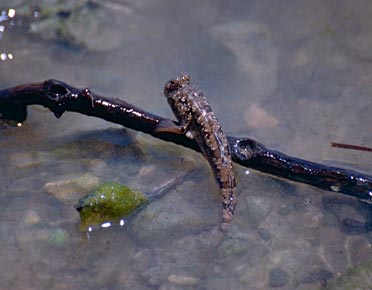 Mudskippers in their natural habitats like small perches near to water credit
Mudskippers in their natural habitats like small perches near to water credit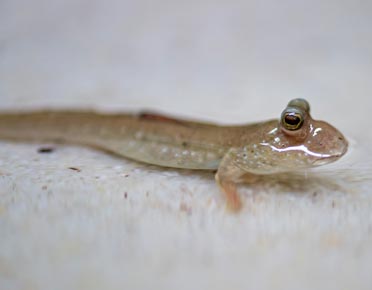 Large eyes on the top of mudskippers heads give a great panoramic view credit
Large eyes on the top of mudskippers heads give a great panoramic view credit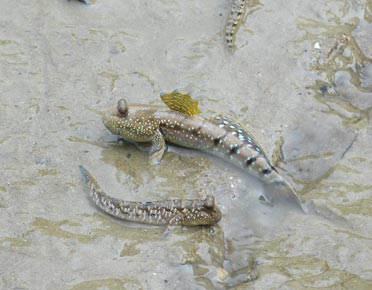 Mudskippers display by holding colorful dorsal fins up in the air credit
Mudskippers display by holding colorful dorsal fins up in the air credit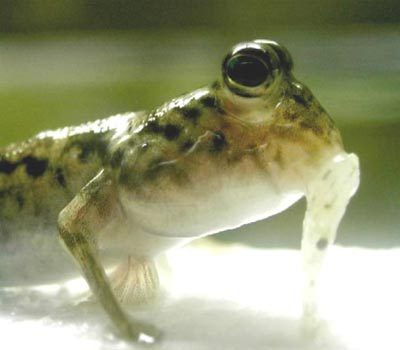
In the wild, mudskippers spend most of their time close to water. Although they can breathe through their skin, they have to be moist to do so. In the mudflats that they inhabit small shallow puddles are everywhere, but in hot conditions, the fish regularly roll themselves in the mud to keep wet. Mudskippers naturally live in brackish water, so be prepared to add a bit of salt water to the tank. A pH of about 8 to 8.5 is required for these guys to feel at home.
There are about 35 species living in brackish coastal waters in tropical, sub tropical and temperate regions from Africa, South East Asia and Australia. The Mudskipper habitat is generally coastal mudflats and mangrove swamps, always moist, and generally quite muddy.
Although mudskippers will tolerate a variety of conditions, they are happiest in brackish water with a specific gravity of between 1.005 – 1.015. Temperatures of 25°C and over are required. A tight fitting lid is not essential for mudskippers, they will not escape. However they do need to remain moist, and a lidded tank will have a much greater humidity, so is certainly beneficial.
Although not essential, some mudskipper aquariums even have simulate tides, by regularly pumping extra water from a sump into the tank. This is a complicated technique to automate, but quite something if you can get it right.
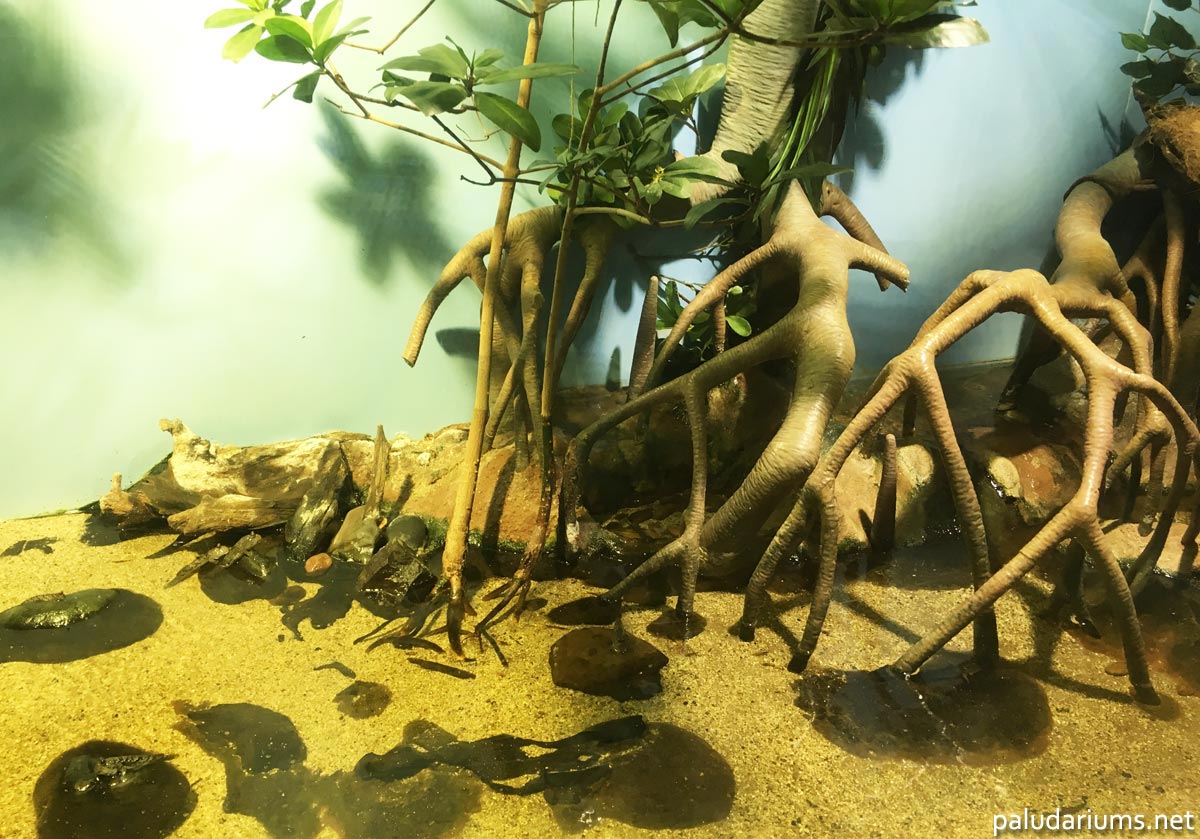 This large mudskipper paludarium at The Deep, Hull, UK recreates the mangrove swamps in which they inhabit
This large mudskipper paludarium at The Deep, Hull, UK recreates the mangrove swamps in which they inhabit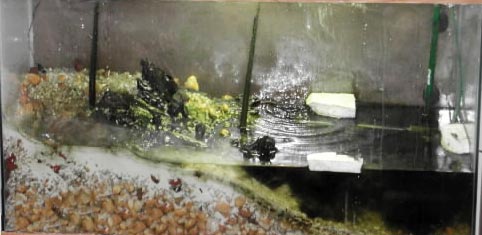 In it's simplest form, a mudskipper setup needs a slope of gravel and sand from a 'land' area to a 'sea area'. Much more interesting and attractive set ups using mangrove roots, wood, rocks and plants are preferable
In it's simplest form, a mudskipper setup needs a slope of gravel and sand from a 'land' area to a 'sea area'. Much more interesting and attractive set ups using mangrove roots, wood, rocks and plants are preferableThese fish are difficult to keep and require a specific mudskipper tank setup to do so. With the correct environment it is possible, though most readily available aquariums are too small. It should be around 50% land and 50% water by volume, preferably broad and shallow, the depth of the water in the deepest parts should not exceed 6-10 inches. The transition into land should be gradual, like that of a shore, so that the mudskippers can easily get from water to land. The mud found in natural habitats is not an appropriate substrate for a paludarium, and typically fine grand sand or gravel is better. Naturally, such gradients tend to be difficult to maintain, especially in sand. Embedding rocks, stones, bogwood (mopani) and mangrove roots into the substrate can greatly aid in maintaining the overall shape of the 'beach', plus create territories for individual fish. The mangrove roots, in particular, give the tank an authentic feel. Artificial resin roots are widely available and look great in tanks large enough to accommodate them.
Less-square tanks can be set up a tank with a beach at either end, and a water section in the middle. This is often the best approach in long tanks without much width. Mudskippers can be highly territorial, and somewhat aggressive to each other; this set-up defines distinct territories helping to reduce quarreling.
Some mudskipper species will dig tunnels, both to avoid predators, but also to breed. Although this may occur in captivity, mudskipper reproduction is not generally achieved in aquaria.
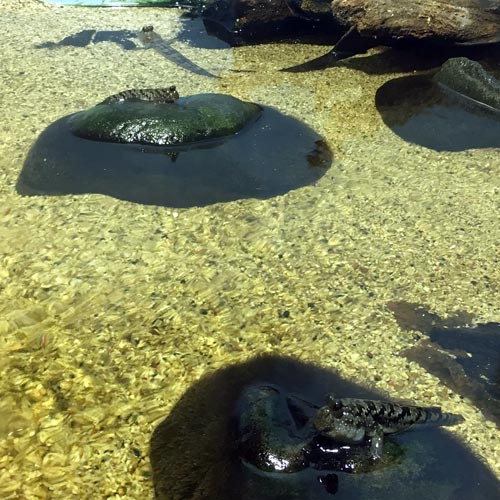 A paludarium with little islands (in this case rounded stones) offers territories for individual fish, somewhat reducing aggression
A paludarium with little islands (in this case rounded stones) offers territories for individual fish, somewhat reducing aggressionIn the mudflats of the wild, these fish struggle to see each other, hence the eyes on top of their heads. They famously raise their fins and leap into the air, so other individuals can locate them. Unfortunately, in the confines of the paludarium large aggressive males will fight and even kill other mudskippers. A well arranged tank with numerous visual barriers (rocks, stones, wood and emersed plant leaves) can really reduce confrontations. Firstly, they demarcate territories, but primarily because the fish simply do not continually see each other, and sub-dominant animals get a place to hide. A large tank is important to give every individual space.
Mudskippers naturally live in mangrove swamps located in marshes or in coastal regions. They like to cling to these mangroves and consider them to be their natural habitat. Keeping Mangroves inside of Paludariums is not very difficult if you have space, and should make the mudskippers feel safe at home. Artificial mangroves are also an excellent way to get an instantly authentic biotope, having the root-thickness of a much taller plant than most tanks can accomodate. Other plants that tolerate brackish water are perfect: Java moss, Java fern and Anubias probably being the best examples. Anubias will grow semi emersed, the leaves providing extra 'perches' for mudskippers.
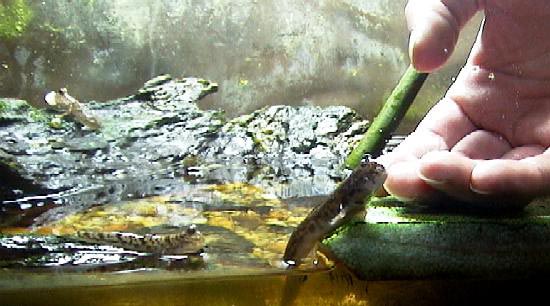
Feeding these fish is not very difficult, they will take almost all frozen and some dry food but they must eat on land. Bloodworm, artemia, squid and krill are all favourites, In the wild they will even eat small crabs, crickets, worms and other live foods. Ensure live foods do not dig down into the substrate and die, beyond the mudskippers reach. If the food falls into the water it will usually be ignored. A simple way to feed them is to create little floating islands made out of Styrofoam. After a few days the mudskippers are even likely to feed straight out of the owners hand.
There are several species of mudskipper, in the genera Periophthalmus and Boleophthalmus. Most are large and aggressive, but some of the smaller species are quite well suited for captivity, and are regularly seen in the aquarium trade. Depending on the size of your tank, it may be best to choose a smaller species of mudskipper; pet stores may only stock juvenile fish. Be sure you know the adult size of the fish you purchase.
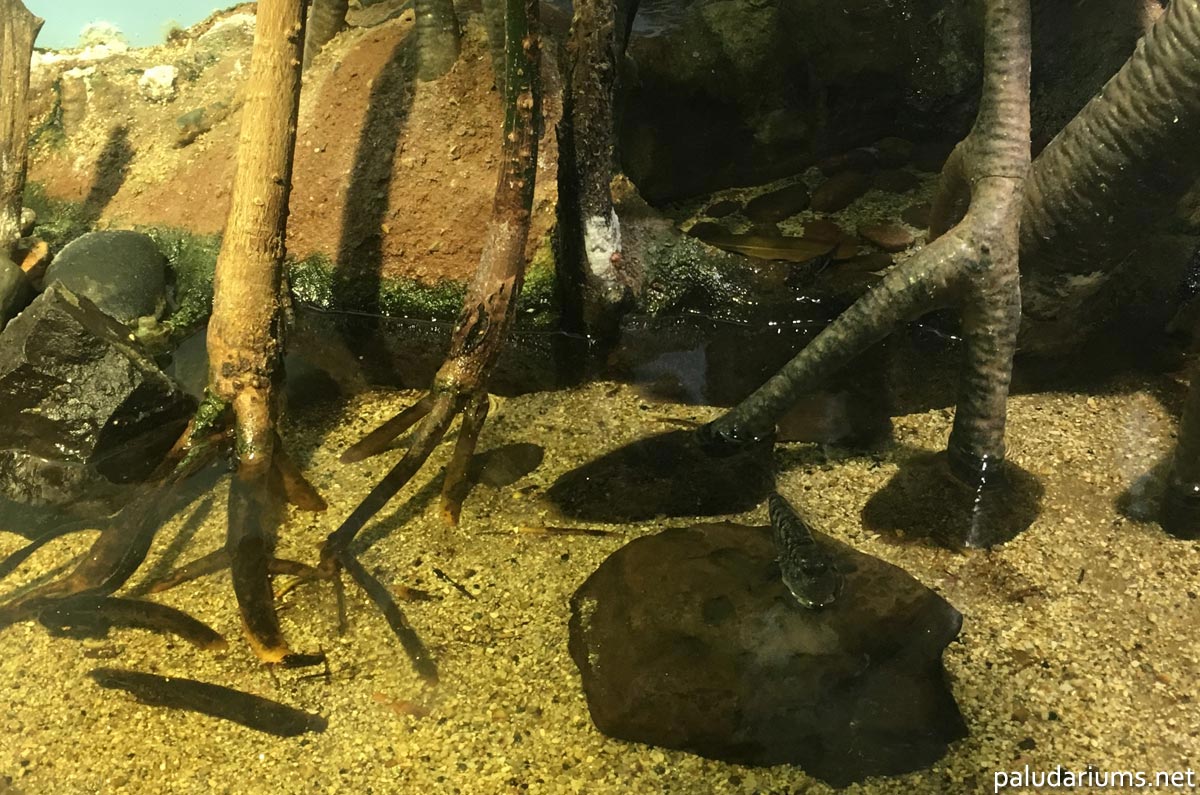 A mudskipper paludarium with artificial mangrove roots, flat stones and shallow water
A mudskipper paludarium with artificial mangrove roots, flat stones and shallow waterThis wonderful 3 foot wide tank has a waterproof glass bottom, and adequate front window ventilation to keep the front glass clear. Although marketed as a Terrarium, it works as the perfect Paludarium. Front-opening doors, and removeable top for easy access and effective maintenance. Available in a wide range of sizes: with a larger surface area for ground/water dwelling species, or taller for leaf dwellers. Suitable for just about any paludarium inhabitant.
The top is equipped with closable inlets on both sides - this allows access for wires and tubing without offering an escape route for paludarium animals or the tiny invertebrates with which they are being fed. Suitable for powering Heat Wave rocks, waterfalls, filters and sensors, or injecting water through misting systems, external canister filters, etc.
All in all a great enclosure, providing a perfect environment for plants and animals, yet easy maintenance for the paludarium keeper. Available from Amazon and other good pet stores.